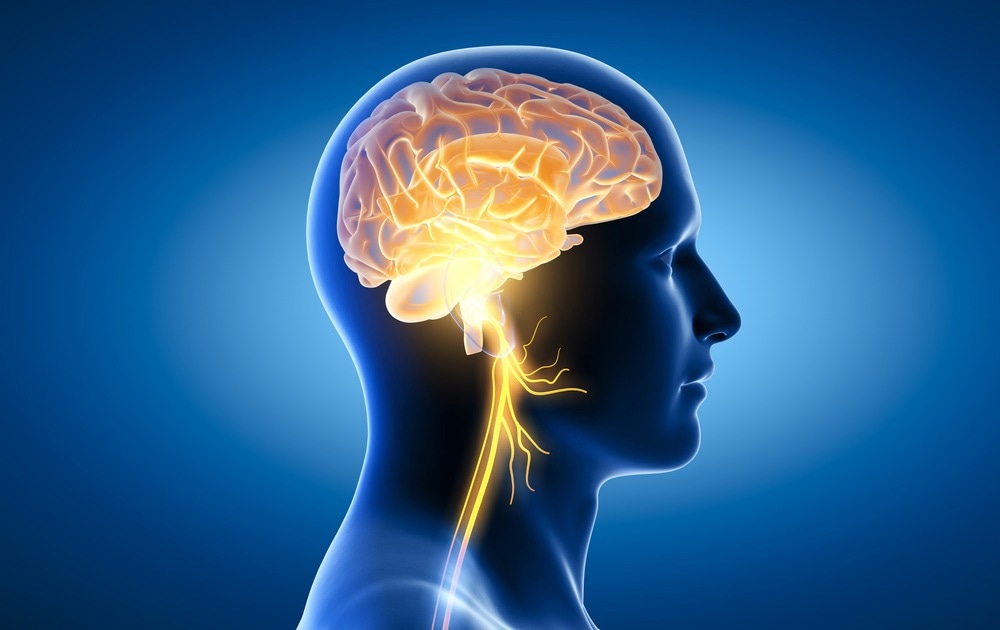Understanding the brain stem
Brain stem and neurological health
The brain stem in disease and disorders
Advancements in brain stem research
Conclusion
References
Further reading
In this article, the crucial role of the brain stem in maintaining neurological health will be explored. The brain stem is central to many neurological processes, the interruption of which can lead to disastrous consequences. Therefore, the brain stem has become the focus of numerous researchers aiming to diagnose or treat disease.

Image Credit: Axel_Kock/Shutterstock.com
Understanding the brain stem
The brain stem is a portion of the brain made of four distinct sections: the diencephalon, mesencephalon, pons, and medulla oblongata. Each of these sections has associated functions which are vital to human health.
Working from the base of the brain stem up, the medulla oblongata connects the brain stem to the spinal cord. The medulla oblongata is the origin point for several cranial nerves (a set of 12 paired nerves that emerge before the first vertebrae of the spine), including the 9th, 10th, 11th, and 12th. 1 Alongside the cranial nerves, many other nuclei originate from the medulla oblongata, and numerous tracts also descend through the area. 2
The term pons is derived from the Latin for bridge, describing how the pons connects the cerebellar hemispheres. The pons also contains cranial nerves, holding the nuclei of the 5th, 6th, 7th, and 8th. 1 Superior to the pons is the mesencephalon, sometimes called the midbrain. 1
The midbrain contains the nuclei of the 3rd and 4th cranial nerves. Due to the presence of the oculomotor and trochlear nerves (3rd and 4th cranial nerves) this area plays a major role in the control of eye movements. The centers for visual reflexes are also found in the midbrain. 1
The diencephalon sits atop the brainstem. This area is made up of multiple structures, including the thalamus, hypothalamus, epithalamus, and subthalamus, all of which sit around the 3rd ventricle. 1 The roles of these areas are numerous and incredibly important. The thalamus, for example, serves as a major relay for all sensory tracts, both as a first, and higher-order relay 3
The first consensus on the features of the brain stem was reached in the 1880s. However, descriptions by anatomists can be traced back to 1543 by Andreas Vesalius. In the 19th century, the brain stem's role in cardiac and respiratory functions was often studied through lesioning specific areas. It was not until the 20th century that full clinical examinations and EEG research were described. 4
Functions such as the vestibulo-ocular reflex and the role of the brainstem in sleep and wakefulness were described during this time. During this time, the first research into loss of function in the brain stem due to injury or disease was underway. Brainstem death, as it was termed, has since become another way to categorize death. 4,5
Brain stem and neurological health
Cranial nerves located within the brain stem play a critical role in normal bodily function. The 10th cranial nerve is the main nerve in the parasympathetic pathway, controlling for the "rest and digest" response. Wherein heart rate decreases and digestive activity increases, alongside other features. 6
The brainstem also contributes to the opposite side of autonomic function, the sympathetic pathway. This is commonly known as the "fight or flight" response and is associated with increased heart rate, blood pressure, and other stress responses. Labeling studies have shown these autonomic command center nuclei in the brainstem. 7
The medulla oblongata is also responsible for respiratory control. Specifically, the respiration cycle is controlled by a pair of oscillators known as the medullary respiratory rhythm generators. This activity is further modulated by other areas of the brain stem, eventually feeding down to the motoneurons of the spinal cord. 8
The brain stem in disease and disorders
Various neurological disorders are associated with brain stem dysfunction. This dysfunction arises due to alterations in the anatomy of the brain stem, such as lesions.
In-depth descriptions of lesions in Parkinson's disease (PD) can be found as early as 1953, with research suggesting that in some cases, lesions are observed in the brain stem before the substantia nigra, the area typically associated with PD pathology. 9,10
Brainstem Pathologies associated with PD can lead to cardiac and respiratory dysfunction. Lesions caused by these pathologies may interrupt the function of the respiratory control, parasympathetic, and sympathetic neurons, in turn compromising autonomic functions.
In a study of lesions present in the medulla oblongata of PD patients, these lesions correlated with variance in respiratory frequency and a lowered heart rate. The appearance of these features, the researchers concluded, was due to an imbalance of sympathetic/vagal activity. 11
Multiple Sclerosis (MS) is another disorder that leads to lesions within the brainstem. 12 Brainstem involvement in MS may manifest as double vision, wobbly gait, facial weakness, and many other features. In a 2022 meta-analysis, lesions of the brainstem in MS were associated with poorer disease outcomes. 13
Advancements in brain stem research
Although anatomically, a lot of the insight we have about the brainstem is derived from dissection, the invention of magnetic resonance imaging has offered the potential for massive steps in studying the brainstem in vivo.
Although there are certain hold-ups in the use of MRI specific to the study of the brainstem, advances in imaging have allowed for several discoveries in brainstem function and anatomy. 14,15
MRI studies focussing on early-stage Alzheimer's disease using voxel-based morphometry (VBM) aided in the identification of neurodegenerative changes in the brainstem. 16
While proving early-stage changes in this disease, this paper also shows the power of VBM in identifying degeneration in the brainstem. 16 Such a technique may have use in clinically in assessing for the presence of lesions in patients with complaints associated with damage of the brainstem.

Image Credit: Gorodenkoff/Shutterstock.com
Using post-mortem ex-vivo MRI of the brainstem, an online interactive atlas at high spatial resolution has been created. As the structure and anatomy of the brainstem are well conserved between individuals, this atlas may prove beneficial in neurosurgery of the region. Surgeons could use this tool to prepare procedures, identifying target nuclei and areas to be avoided. 17
Conclusion
Due to the functional significance of the brainstem in both autonomic bodily functions and neurological health, the brainstem is crucial for daily life. In disorders where the brainstem is affected, such as via lesions in the highlighted neurodegenerative disorders, health outcomes can be poor.
These associated poorer disease outcomes have led to researchers focusing on this critical area. As disease effects and functional aspects of the brainstem are uncovered by improved in vivo imaging techniques, diagnosis speed, and future treatments may be developed.
References
- Ángeles Fernández-Gil M, Palacios-Bote R, Leo-Barahona M, Mora-Encinas JP. Anatomy of the Brainstem: A Gaze Into the Stem of Life. Semin Ultrasound, CT MRI. 2010;31(3):196-219. doi:10.1053/j.sult.2010.03.006
- Iordanova R, Reddivari AKR. Neuroanatomy, Medulla Oblongata. 2023. http://europepmc.org/abstract/MED/31869070.
- Sherman SM. The thalamus is more than just a relay. Curr Opin Neurobiol. 2007;17(4):417-422. doi:10.1016/j.conb.2007.07.003
- Wijdicks EFM. Historical awareness of the brainstem. Neurology. 2020;95(11):484-488. doi:10.1212/WNL.0000000000010504
- NHS. Overview: Brain Death.
- Capilupi MJ, Kerath SM, Becker LB. Vagus Nerve Stimulation and the Cardiovascular System. Cold Spring Harb Perspect Med. 2020;10(2):a034173. doi:10.1101/cshperspect.a034173
- Jansen ASP, Van Nguyen X, Karpitskiy V, Mettenleiter TC, Loewy AD. Central Command Neurons of the Sympathetic Nervous System: Basis of the Fight-or-Flight Response. Science (80- ). 1995;270(5236):644-646. doi:10.1126/science.270.5236.644
- Ikeda K, Kawakami K, Onimaru H, et al. The respiratory control mechanisms in the brainstem and spinal cord: integrative views of the neuroanatomy and neurophysiology. J Physiol Sci. 2017;67(1):45-62. doi:10.1007/s12576-016-0475-y
- Greenfield JG, Bosanquet FD. THE BRAIN-STEM LESIONS IN PARKINSONISM. J Neurol Neurosurg Psychiatry. 1953;16(4):213-226. doi:10.1136/jnnp.16.4.213
- Del Tredici K, Rüb U, de Vos RAI, Bohl JRE, Braak H. Where Does Parkinson Disease Pathology Begin in the Brain? J Neuropathol Exp Neurol. 2002;61(5):413-426. doi:10.1093/jnen/61.5.413
- Pyatigorskaya N, Mongin M, Valabregue R, et al. Medulla oblongata damage and cardiac autonomic dysfunction in Parkinson disease. Neurology. 2016;87(24):2540-2545. doi:10.1212/WNL.0000000000003426
- Dobson R, Giovannoni G. Multiple sclerosis – a review. Eur J Neurol. 2019;26(1):27-40. doi:10.1111/ene.13819
- Yang Y, Wang M, Xu L, et al. Cerebellar and/or Brainstem Lesions Indicate Poor Prognosis in Multiple Sclerosis: A Systematic Review. Front Neurol. 2022;13(April). doi:10.3389/fneur.2022.874388
- Sclocco R, Beissner F, Bianciardi M, Polimeni JR, Napadow V. Challenges and opportunities for brainstem neuroimaging with ultrahigh field MRI. Neuroimage. 2018;168(2):412-426. doi:10.1016/j.neuroimage.2017.02.052
- Beissner F. Functional MRI of the Brainstem: Common Problems and their Solutions. Clin Neuroradiol. 2015;25(S2):251-257. doi:10.1007/s00062-015-0404-0
- Ji X, Wang H, Zhu M, et al. Brainstem atrophy in the early stage of Alzheimer's disease: a voxel-based morphometry study. Brain Imaging Behav. 2021;15(1):49-59. doi:10.1007/s11682-019-00231-3
- Adil SM, Calabrese E, Charalambous LT, et al. A high-resolution interactive atlas of the human brainstem using magnetic resonance imaging. Neuroimage. 2021;237(April):118135. doi:10.1016/j.neuroimage.2021.118135
Further Reading
Last Updated: Jan 24, 2024